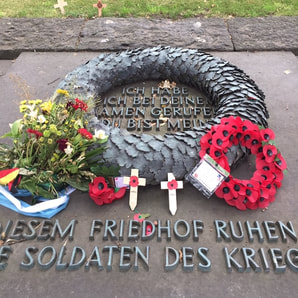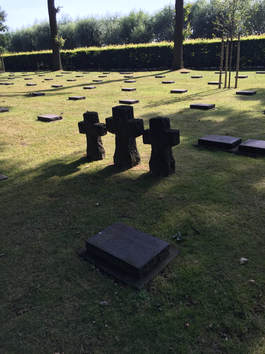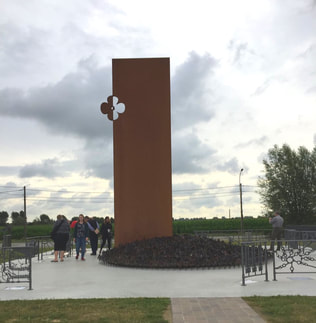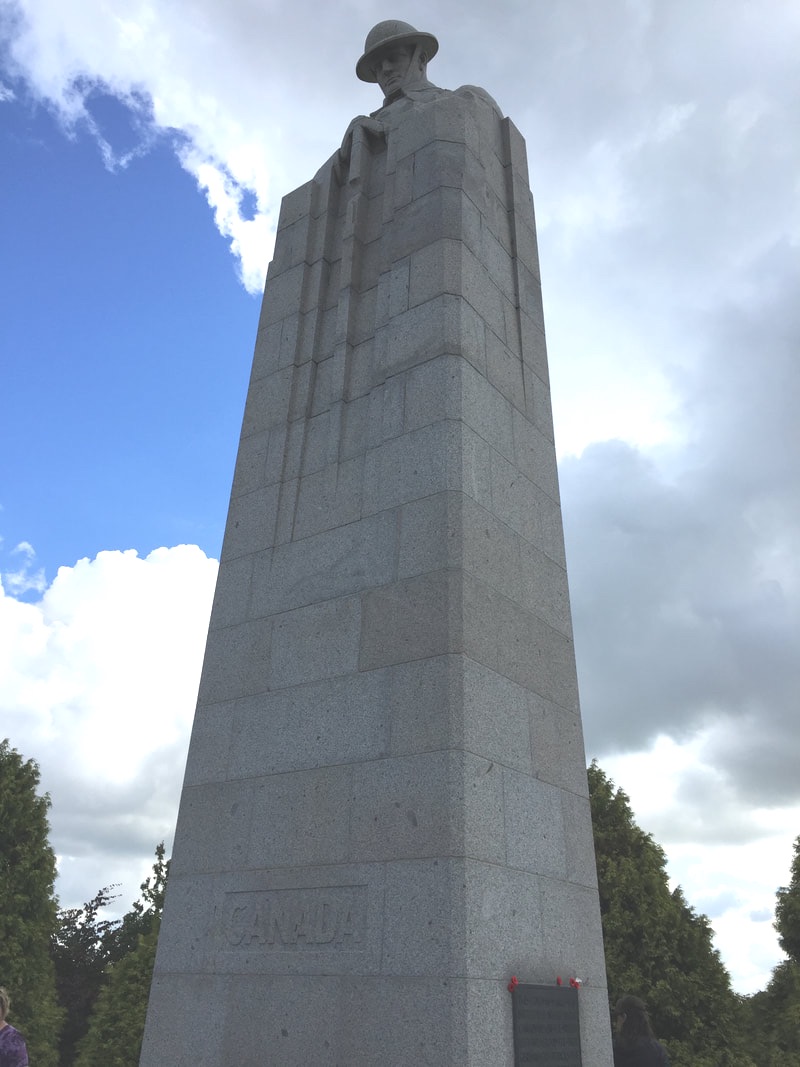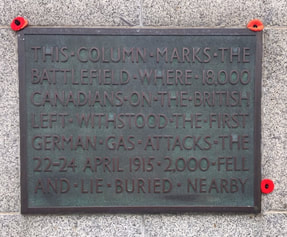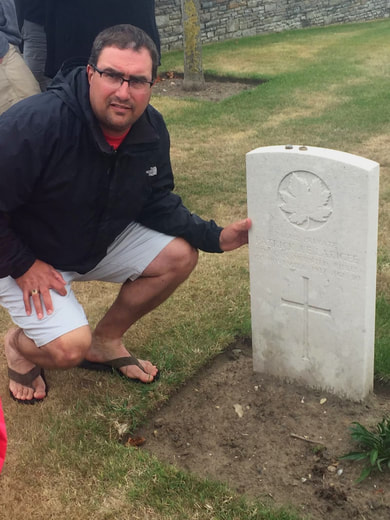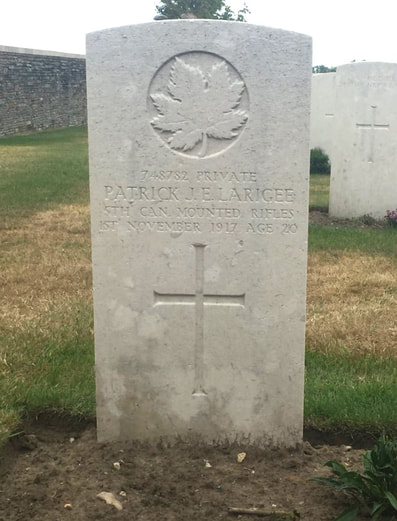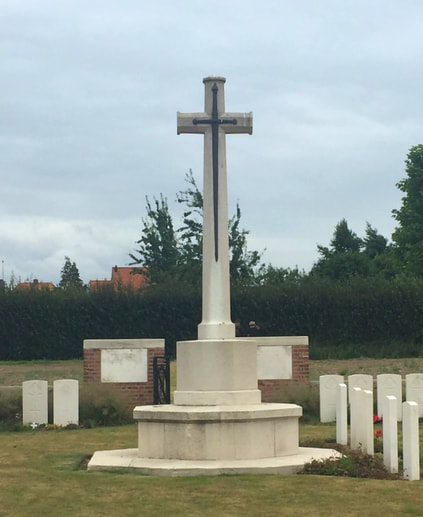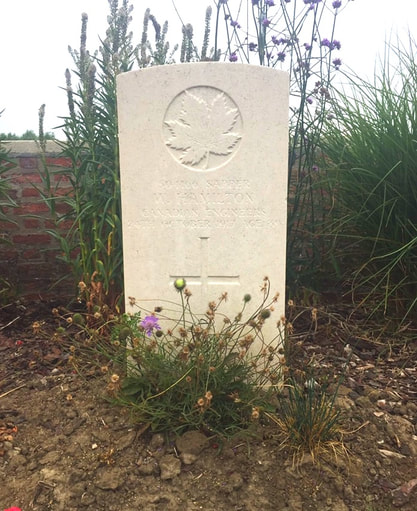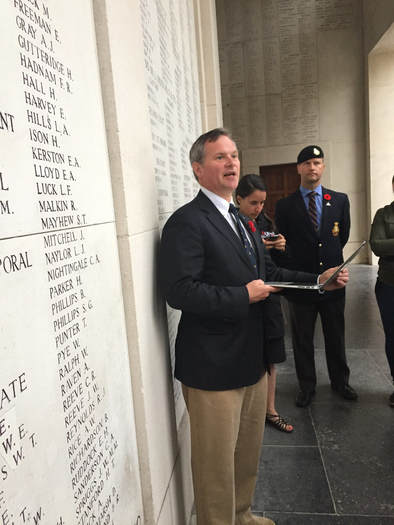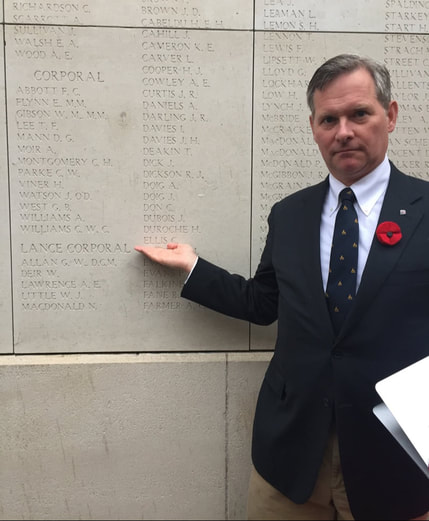"How do we determine what is historically significant?"
Today's Itinerary and Activities
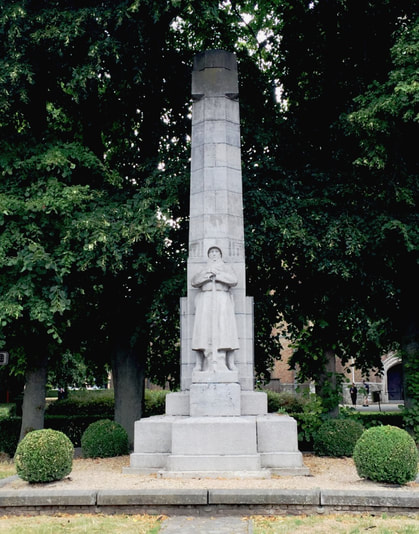 Langemarck's cenotaph
Langemarck's cenotaph
Today we learned about the historical significance of Canada's experiences in the Ypres Salient between 1915 and 1917.
We began our day in the town of Langemarck where we shared our responses to the question that Cindy posed yesterday: Given the German and British objectives in 1914, what did these countries need to consider with regards to the Belgian and French civilians living on the Western Front?. Following this, we explored the town's main square, which is home to a church, a cenotaph, and information plaques.
Our next stop was the Langemarck German Military Cemetery where we discovered and explored the newly-installed Poppy Cenotaph and considered the purpose of the German cemetery.
We then drove to Vancouver Corner where we considered the intent of the St. Juliaan/St. Julien Canadian Memorial (also known as the Brooding Soldier). We also pondered why the monument was erected at this specific spot. After our analysis of the monument, Lee shared his views of why the Second Battle of Ypres is historically significant. Following this, we visited the Hill 62 (Sanctuary Wood) Canadian Memorial where we received maps and completed a map activity that involved us determining our exact location in the Ypres Salient. Lee also taught us about the Canadians' contributions to the Battle of Mont/Mount Sorrel.
The next stop on the tour was the Passchendaele Canadian Memorial at Crest Farm. The cube monument located there commemorates Canada's experiences during the Third Battle of Ypres, which is more commonly known as Passchendaele. While at Crest Farm, we gained insights into the final major battle in the Ypres Salient. After leaving Crest Farm, we visited two cemeteries - the Passchendaele New British Cemetery and the Wieltje Farm Cemetery - where Robert and Alexander presented their soldier biographies.
When we returned to our hotel, Ronda conducted her seminar, which was related to memorials and monuments. We then had the opportunity to visit the In Flanders Fields Museum.
At the close of the day, we attended the Last Post Ceremony at the Ypres (Menin Gate) Memorial. Before returning to our hotel, Joel shared with us the life of the soldier he researched, who is one of 55,000 individuals commemorated on the Menin Gate.
We began our day in the town of Langemarck where we shared our responses to the question that Cindy posed yesterday: Given the German and British objectives in 1914, what did these countries need to consider with regards to the Belgian and French civilians living on the Western Front?. Following this, we explored the town's main square, which is home to a church, a cenotaph, and information plaques.
Our next stop was the Langemarck German Military Cemetery where we discovered and explored the newly-installed Poppy Cenotaph and considered the purpose of the German cemetery.
We then drove to Vancouver Corner where we considered the intent of the St. Juliaan/St. Julien Canadian Memorial (also known as the Brooding Soldier). We also pondered why the monument was erected at this specific spot. After our analysis of the monument, Lee shared his views of why the Second Battle of Ypres is historically significant. Following this, we visited the Hill 62 (Sanctuary Wood) Canadian Memorial where we received maps and completed a map activity that involved us determining our exact location in the Ypres Salient. Lee also taught us about the Canadians' contributions to the Battle of Mont/Mount Sorrel.
The next stop on the tour was the Passchendaele Canadian Memorial at Crest Farm. The cube monument located there commemorates Canada's experiences during the Third Battle of Ypres, which is more commonly known as Passchendaele. While at Crest Farm, we gained insights into the final major battle in the Ypres Salient. After leaving Crest Farm, we visited two cemeteries - the Passchendaele New British Cemetery and the Wieltje Farm Cemetery - where Robert and Alexander presented their soldier biographies.
When we returned to our hotel, Ronda conducted her seminar, which was related to memorials and monuments. We then had the opportunity to visit the In Flanders Fields Museum.
At the close of the day, we attended the Last Post Ceremony at the Ypres (Menin Gate) Memorial. Before returning to our hotel, Joel shared with us the life of the soldier he researched, who is one of 55,000 individuals commemorated on the Menin Gate.
Given the German and British objectives in 1914,
what did these countries need to consider with regards to
the Belgian and French civilians living on the Western Front?
Possible Considerations of the British ArmyThese are some of the ideas shared by the syndicates that considered the question from the British perspective:
|
Possible Considerations of the German ArmyThese are some of the ideas shared by the syndicates that considered the question from the British perspective:
|
"A lesson does not need to be wrapped up in a bow."
At the beginning of the day, Blake explained that it is not necessary to include wrap-ups at the end of lessons. He advised that if teachers leave lessons open-ended, students have the opportunity to mull over different perspectives, and this might enable them to come to a resolution on their own.
Historical Significance
Today we learned that it is important for teachers to allow their students to determine which individuals and events are historically significant. Blake shared that in order to determine whether a person or an event is historically significant, students must consider the following:
- How many people were affected by the event?
- What was the scope or domino effect of the event?
- What was the long-term or enduring effect of the event?
Langemarck German Military Cemetery
|
The Langemarck German Military Cemetery is the final resting place of over 40,000 German soldiers, more than 20,000 of whom are buried in a mass grave. The cemetery includes gravestones, each of which commemorate eight soldiers; panels that list the German soldiers who went missing in action; statues; and bunkers.
The Langemarck German Military Cemetery has a very different look and feel than the Commonwealth cemeteries that we have visited. Jessica, Karen, and Lorelei shared how they felt as they entered and walked through the German Cemetery.
|
The Poppy Cenotaph
|
Originally erected in the Grote Markt outside of the In Flanders Fields Museum in Ypres, the Poppy Cenotaph is now located outside of the Langemarck German Military Cemetery. It commemorates all civilians and militaries that were involved in the First World War. Featuring the designs of European children, it was constructed in September 2016 by blacksmiths from around the world.
Vanessa explained what she believes is the intent of this newly-installed cenotaph:
|
Key Points to Consider About the First Use of Poison Gas
While at Vancouver Corner, Lee led a discussion about the Second Battle of Ypres. We learned that poison gas was introduced as a weapon of war during the first days of this battle, on April 22, 1915 and April 24, 1915. Cindy also informed us that international law actually existed regarding the the use of poison gas and that the law was signed by many nations. She further explained that the 1907 update of the Hague Convention's primary document stated that it was against law to launch projectiles of poison gas.
At the Second Battle of Ypres, the German Army did not use projectiles. Instead, they used huge canisters of gas and relied on winds to carry the gas over No-Man's-Land to the Allies' trenches. Did the Germans break the law?.
At the Second Battle of Ypres, the German Army did not use projectiles. Instead, they used huge canisters of gas and relied on winds to carry the gas over No-Man's-Land to the Allies' trenches. Did the Germans break the law?.
Vancouver Corner
The Significance of Terrain
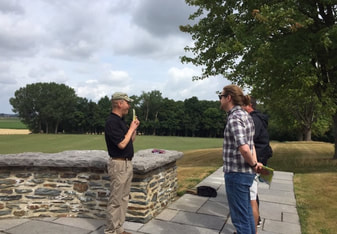 Lee instructs participants on how to use maps
Lee instructs participants on how to use maps
While at Mont/Mount Sorrel, Lee taught us that during the First World War, aspects of the land such as its slope helped defending armies choose where to entrench and helped offending armies choose where to attack.
We also discussed the importance of teaching students how to study the terrain in order to determine the reasons behind battles. Before leaving Mont/Mount Sorrel, we completed a map reading activity that can be used to teach both map reading skills and First World War history.
At the end of the tour, Ronda reflected on what terrain can tell us during inquiry-based learning activities:
We also discussed the importance of teaching students how to study the terrain in order to determine the reasons behind battles. Before leaving Mont/Mount Sorrel, we completed a map reading activity that can be used to teach both map reading skills and First World War history.
At the end of the tour, Ronda reflected on what terrain can tell us during inquiry-based learning activities:
- Ronda: "Terrian is so important. Because so many of us live a life distant from the natural world, we forget how significant it is. Anyone who has walked over a field, climbed a mountain, lived on a river bank or floodplain, or saw for miles and miles from the top of a hill can inherently recognize how important terrain is to us. I think it is empowering to be able to look at a map and the land you are on and recognize the physical characteristics represented on that piece of paper. To be able to look around you and hypothesize how the landscape, vegetation, landmarks, and buildings could have influenced what happened takes you beyond reading toward understanding. Why did people move through this area? Why did they live here? Why was this an area for hunting? How did trade routes influence culture? There are so many ways to use terrain to gain a more in depth understanding of the past."
Soldier Biographies
Robert's Soldier
Private Patrick J. E. Larigee
5th Canadian Mounted Rifles
Passchendaele New British Cemetery
Private Patrick J. E. Larigee
5th Canadian Mounted Rifles
Passchendaele New British Cemetery
Seminar
Upon returning to our hotel, Ronda guided us through a large group discussion about memorials and monuments. Throughout the discussion, she probed us for possible answers to the questions below:
- Do countries such as Belgium and France have an obligation to provide space for other countries to commemorate their war dead?
- How can we foster engagement in memorials, ceremonies, and remembrance?
The Last Post Ceremony
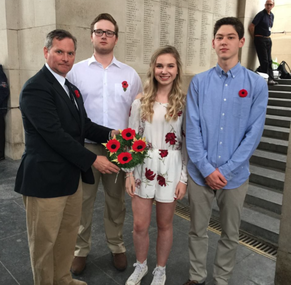 (From left) Joel, Alex, Emily, and Andrew
(From left) Joel, Alex, Emily, and Andrew
This evening we attended the Last Post Ceremony at the Ieper/Ypres (Menin Gate) Memorial, which lists the names of 55,000 Commonwealth soldiers who went missing in action in Belgium during the First World War. With the exception of May 20, 1940 - September 6, 1944, the Last Post Ceremony has been held at the Menin Gate at 8:00pm every night since November 11, 1929.
Alex, Andrew, Emily, and Joel laid a wreath at the Memorial on our group's behalf.
Alex, Andrew, Emily, and Joel laid a wreath at the Memorial on our group's behalf.
|
This video captures a few minutes of the Last Post Ceremony that we attended.
|
This video captures Alex, Andrew, Emily, and Joel laying a wreath.
|
